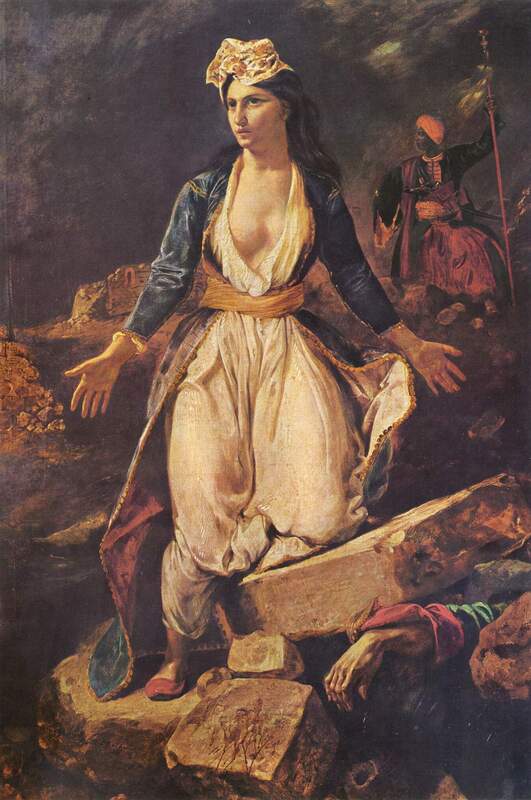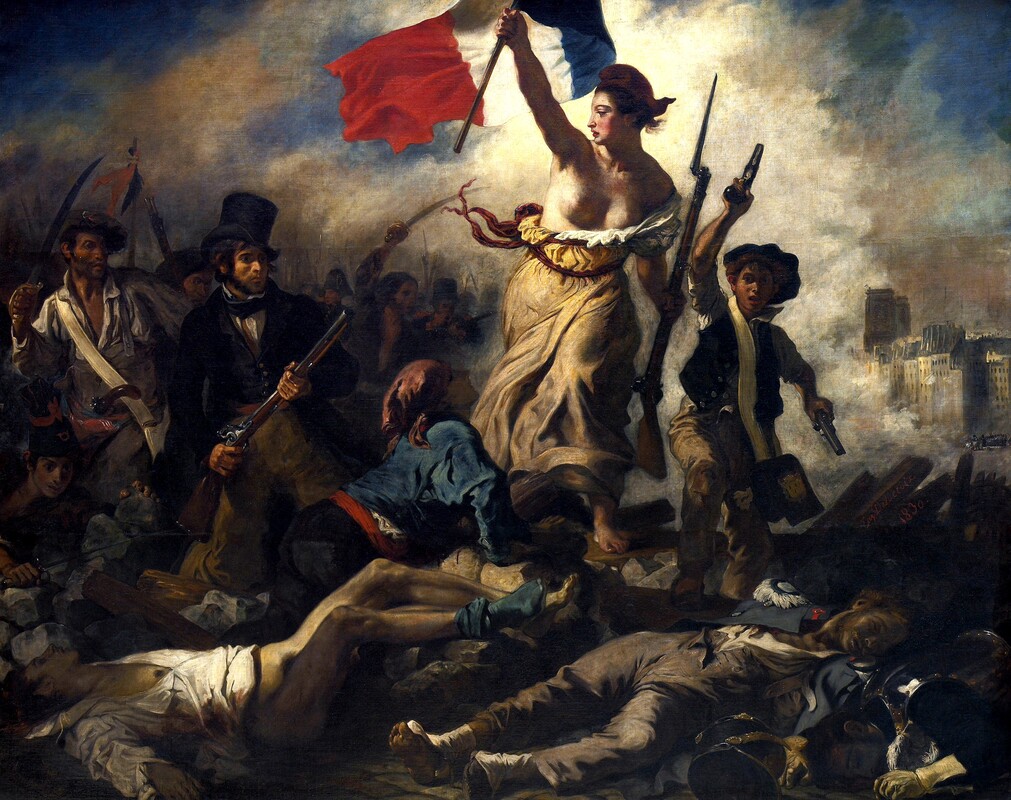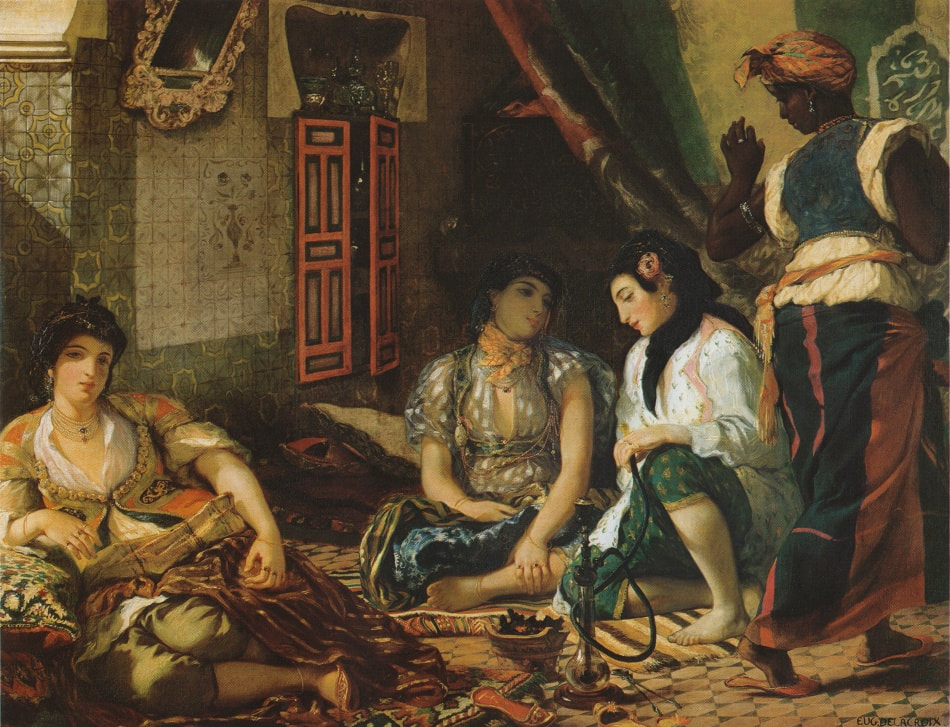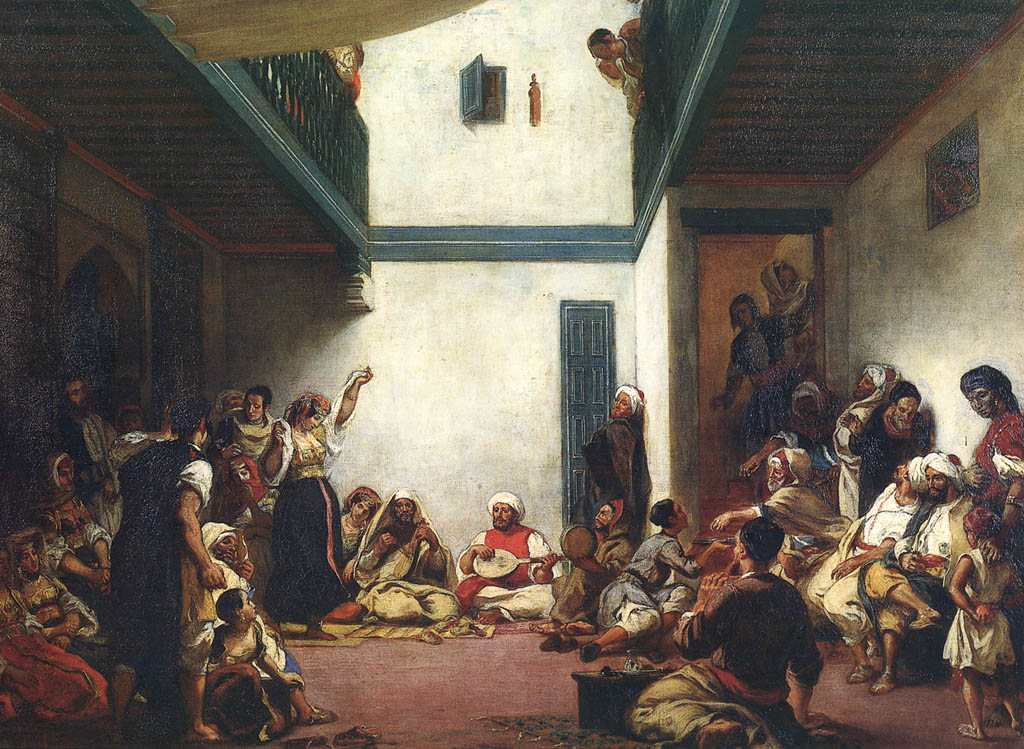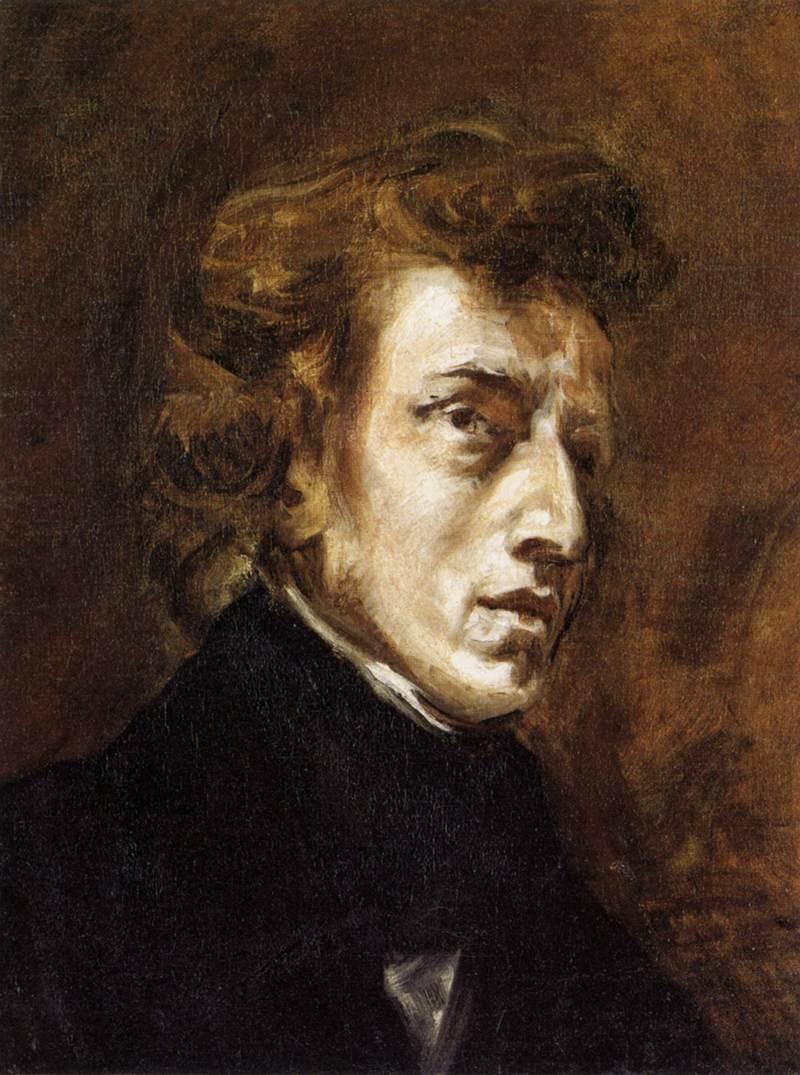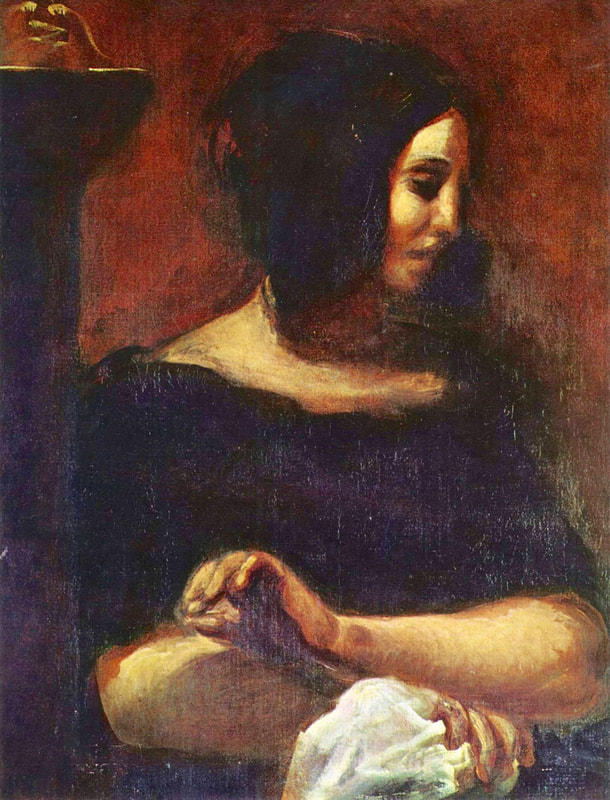AN APPRECIATION: Eugene Delacroix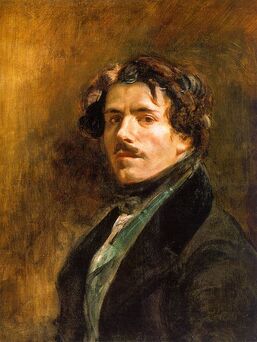 Self-portrait. Self-portrait.
Eugene Delacroix has been called the last of the Old Masters but his work opened the door for Modern Art. His work influenced the avant garde artists of the second half of the 19th century who in turn influenced the artists of the 20th century. As such, Delacroix transcends being a Romantic painter and is unique.
Ferdinand-Victor-Eugene Delacroix was born into controversy in 1798. France had just gone through the chaos of the revolution and the tumult of the Napoleonic era was beginning. Charles Delacroix was a high ranking official in the French government and his wife, Victoire Oeben, was prominent in French society. Eugene's brothers were in the military - - one died in battle while the other went on to become a general under Napoleon. His sister married a diplomat. Thus, the family lived at the center of the storm. But the family's position in the world of politics was not the only reason Eugene's birth was controversial. Eugene's siblings were considerably older than him. In addition, Eugene was conceived at a time that Charles was away from Paris on a diplomatic mission and furthermore, there is evidence that Charles was no longer medically capable of fathering a child. This led many to suspect that Eugene's father was actually Prince Charles-Maurice de Talleyrand-Périgord who was a family friend and who served as foreign minister not only under Napoleon but under the restored Bourbon monarchy. When he grew up, Eugene bore a marked resemblance to Talleyrand and Talleyrand took a protective interest in Eugene's career. Charles Delacroix died in 1804 leaving Victorie quite wealthy. However, through mismanagement, the fortune was all but gone by the time she died in 1814. An orphan, Eugene went to live with his sister. Nonetheless, Eugene continued his education at some of France's top schools. He greatly enjoyed reading the classics as well as drawing. Having decided to become an artist, Delacroix studied at the prestigious Ecole des Beaux Arts. At 17, he enrolled to study with the academic painter Pierre Narcisse Guérin. However, Théodore Géricault was a greater influence. Indeed, Delacroix even posed for one of the figures in Gericault's masterpiece “The Raft of the Medusa.” Still, the greatest influence on young Delacroix were the paintings that he studied in the Louvre. He was particularly impressed by the works of Raphael, Michelangelo, Titian and Veronese. His favorite, however, was Peter Paul Rubens. In the 1820s, the way for an artist to achieve success was to exhibit at the biennial Salon of Paris. (It later became an annual exhibition). Artists who exhibited at the Salon might have their works purchased by the government. Also, private collectors viewed the Salon as a stamp of approval and so exhibiting at the Salon could also lead to private sales. Although he was still quite young, Delacroix submitted his first work for the Salon of 1822. “The Barque of Dante” depicted a scene from Dante's Inferno and showed the influence of Gericault and the painters he had studied at the Louvre. Nonetheless, the painting was not only accepted for exhibition but it was purchased by the French government. Delacroix was on his way. Still, there were those who vehemently objected to Delacroix's art. At the time, French art was dominated by the Neo-classical school and the teachings of Jacque-Louis David. Their works were muted with no visible brushstrokes. Line was emphasized over color. Delacroix's art was emotional, often sketch-like and it emphasized color. As a result, Delacroix's attempts to become a member of the Academy of Beaux Arts were rejected until late in his career. Delacroix again caused controversy with his submission for the Salon of 1824, “The Massacre at Chios.” For this painting, Delacroix turned to contemporary events and depicted a massacre of Greek civilians by Turkish soldiers during the Greek war of independence. The Greek cause was championed by Lord Byron and other Romanticists. Delacroix admired Byron and often was inspired by works by Romantic writers, composers and poets. Furthermore, Delacroix's emotional style and use of color made him a leading Romantic painter. Despite the criticisms of the Neoclassicists, the painting won a prize and was purchased by the French government. When the painting was almost finished, Delacroix attended an exhibition that included the works of the English landscape painter John Constable. Delacroix was so impressed by Constable's work that he returned to his studio and re-worked sections of “The Massacre at Chios.” In addition, rather than use the proceeds of the prize that he received for a trip to Rome, which was what most young artists did, Delacroix used it to go to England. There, he not only saw more of Constable's work but met with Sir Thomas Lawrence and Richard Parkes Bonnington. Meanwhile, King Charles X was becoming increasingly repressive. He abolished freedom of the press, closed the Chamber of Deputies and changed the election laws. By 1830, the French people had had enough and rose up in a popular rebellion. It was a successful revolt, which made the liberal Duke of Orleans King Louis-Philippe. The rebellion inspired Delacroix's most famous work “Liberty Leading the People.” It shows a bare-breasted working class woman climbing over a barricade waving the French Tricolor and urging a crowd of men onward. The painting struck a chord with both the critics and the public. It was purchased by the state and Delacroix received the Legion of Honor. In 1832, Delacroix was invited to accompany a diplomatic mission to Morocco. France had recently conquered Algeria and the goal of his mission was to re-assure the Sultan of Morocco that his country was not about to suffer the same fate as its neighbor. Delacroix was not going to be directly involved in the diplomatic work but he decided to go along as an observer. Morocco deeply impressed Delacroix. He liked the light and the colors but more importantly, he saw the people as being living versions of the ancient Greeks and Romans. Filling his sketchbooks, Morocco provided inspiration for paintings Delacroix made throughout the ret of his life. During this trip, he also visited Algeria and Gibraltar. Perhaps the most famous of Delacroix's North Africa paintings is “The Women of Algiers.” It is a scene in a harem but there is nothing erotic about it. Rather, it shows a group of women in North African attire talking and going about everyday activities. The work, with its exotic atmosphere and vibrant colors, would inspire later artists including Pierre-Auguste Renoir, Henri Matisse and Pablo Picasso During the later part of his career, Delacroix concentrated on commissions that he received to paint murals in government buildings and in the churches of Paris. The buildings included the Chamber des Depuities, the Palais du Luxembourg, the Louvre, the Hotel de Ville and Paris' largest church Saint-Sulpice. He also worked on portraits and still-life paintings. In 1855, Emperor Napoleon III decided to have a world's fair as France's response to Britain's Great Exhibition. Included in this Exposition Universelle, was a retrospective exhibition of Delacroix's work. Inasmuch as Delacroix had been publicly acknowledged as one of the great artists of France, the Academy finally granted him membership in 1857. By the 1860s, Delacroix had a large number of admirers. These included Edourad Manet and the young Impressionists who were impressed by his use of color and his expression of emotion. Delacroix always had a frail constitution. The trademark scarf that he often wore around his neck was not just a fashion emblem but was to help deter colds. Nonetheless, in the winter 1862-63, Delacroix caught a virus. Although he had many notorious relationships, he had never married and so he was attended in his illness by his housekeeper Jeanne-Marie le Guillou. She was by him when Delacroix died on August 13, 1863. See our profiles of the Impressionists and members of their circle.
Frederic Bazille Eugene Boudin Marie Bracquemond Gustave Caillebotte Mary Cassatt Paul Cezanne Edgar Degas Henri Fantin-Latour Eva Gonzales Paul Gauguin Armand Guillaumin Edouard Manet Claude Monet Berthe Morisot Camille Pissarro Pierre Auguste Renoir Alfred Sisley Suzanne Valadon Victor Vignon |
Above: "The Massacre at Chois" depicting an incident in the Greek War of Independence.
Below: "Greece on the Ruins of Missolongi" again depicting a scene from the War of Independence. Delacroix's most famous work "Liberty Leading The People".
Delacroix was inspired by his journey to Morocco in 1832. Above: "The Women of Algiers."
Below: "The Jewish Wedding." Delacroix also painted portraits, in this case, his friends Frederic Chopin (above) and George Sands (below).
|
Artist appreciation - Eugene Delacroix

